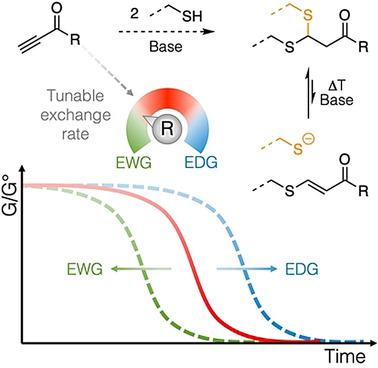当前位置:
X-MOL 学术
›
Angew. Chem. Int. Ed.
›
论文详情
Our official English website, www.x-mol.net, welcomes your feedback! (Note: you will need to create a separate account there.)
Covalent Adaptable Networks with Tunable Exchange Rates Based on Reversible Thiol-yne Cross-Linking.
Angewandte Chemie International Edition ( IF 16.6 ) Pub Date : 2019-12-17 , DOI: 10.1002/anie.201912902 Niels Van Herck 1 , Diederick Maes 1 , Kamil Unal 1, 2 , Marc Guerre 1, 3 , Johan M Winne 2 , Filip E Du Prez 1
Angewandte Chemie International Edition ( IF 16.6 ) Pub Date : 2019-12-17 , DOI: 10.1002/anie.201912902 Niels Van Herck 1 , Diederick Maes 1 , Kamil Unal 1, 2 , Marc Guerre 1, 3 , Johan M Winne 2 , Filip E Du Prez 1
Affiliation

|
The design of covalent adaptable networks (CANs) relies on the ability to trigger the rearrangement of bonds within a polymer network. Simple activated alkynes are now used as versatile reversible cross-linkers for thiols. The click-like thiol-yne cross-linking reaction readily enables network synthesis from polythiols through a double Michael addition with a reversible and tunable second addition step. The resulting thioacetal cross-linking moieties are robust but dynamic linkages. A series of different activated alkynes have been synthesized and systematically probed for their ability to produce dynamic thioacetal linkages, both in kinetic studies of small molecule models, as well as in stress relaxation and creep measurements on thiol-yne-based CANs. The results are further rationalized by DFT calculations, showing that the bond exchange rates can be significantly influenced by the choice of the activated alkyne cross-linker.
中文翻译:

基于可逆硫醇-yne交叉链接的汇率可调的共价自适应网络。
共价适应性网络(CAN)的设计依赖于触发聚合物网络内键重排的能力。现在,简单的活化炔烃用作硫醇的通用可逆交联剂。类似于点击的硫醇-炔交联反应可以通过双迈克尔加成以及可逆和可调的第二加成步骤,轻松地由多硫醇进行网络合成。所得的硫缩醛交联部分是牢固但动态的连接。合成了一系列不同的活化炔烃,并在小分子模型的动力学研究以及基于硫醇炔的CAN的应力松弛和蠕变测量中,对它们产生动态硫缩醛键的能力进行了系统地研究。通过DFT计算进一步合理化结果,
更新日期:2020-01-23
中文翻译:

基于可逆硫醇-yne交叉链接的汇率可调的共价自适应网络。
共价适应性网络(CAN)的设计依赖于触发聚合物网络内键重排的能力。现在,简单的活化炔烃用作硫醇的通用可逆交联剂。类似于点击的硫醇-炔交联反应可以通过双迈克尔加成以及可逆和可调的第二加成步骤,轻松地由多硫醇进行网络合成。所得的硫缩醛交联部分是牢固但动态的连接。合成了一系列不同的活化炔烃,并在小分子模型的动力学研究以及基于硫醇炔的CAN的应力松弛和蠕变测量中,对它们产生动态硫缩醛键的能力进行了系统地研究。通过DFT计算进一步合理化结果,


























 京公网安备 11010802027423号
京公网安备 11010802027423号